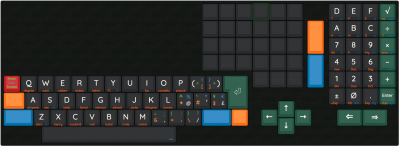Finally got around to sketching a key layout, to see how it might fit together in practice. As a warmup, I started by trying to replicate something more familiar:
Attachment:
 Screenshot 2019-09-15 18.34.58.png [ 110.37 KiB | Viewed 757 times ]
Screenshot 2019-09-15 18.34.58.png [ 110.37 KiB | Viewed 757 times ]
The typeface isn't quite right, but I'm sure many of you recognise that for what it is. Things get somewhat more interesting when I let my creativity out to roam:
Attachment:
 Screenshot 2019-09-15 18.35.18.png [ 141.48 KiB | Viewed 757 times ]
Screenshot 2019-09-15 18.35.18.png [ 141.48 KiB | Viewed 757 times ]
The three orange and three blue shift keys are all ganged together, so only take up two spots on the keymatrix in total. Together they facilitate a calculator-style extended keypad on the right, an alphabetic and symbolic group to the lower left, some navigation keys, and 27 function keys that are not yet assigned functions. The large gap to the upper left seems like a convenient place to put a display.
Close examination of the secondary legends should demonstrate that I'm going for an engineering/programming emphasis with my calculator, rather than the financial/statistical emphasis of most existing "scientific" calculators. The upper half of the keypad allows specifying SI prefixes (deka, hecto, kilo, etc. - and of course deci, centi, milli as well), while the
units those prefixes apply to can also be specified via the alphabetic keys, thus allowing robust dimensional analysis to be implemented (often very useful for checking the correctness of an equation). The reciprocal units are specified by including the blue shift with the orange, as illustrated by the hertz and siemens legends on the same keys as seconds and ohms respectively. I should also be able to find a way to incorporate the English engineering unit systems as scaled versions of the SI ones, consequently getting straightforward unit-conversion functionality almost for free.
At the same time, all of the printable ASCII character set is included in one way or another, so using this keyboard to enter a general-purpose programming language should be quite feasible. The numbers and +/- symbols require moving to the keypad, but all of the brackets are present on just two keys with appropriate modifiers. (The green legends indicate using both of the shift keys together.)
This should actually be quite fun…







